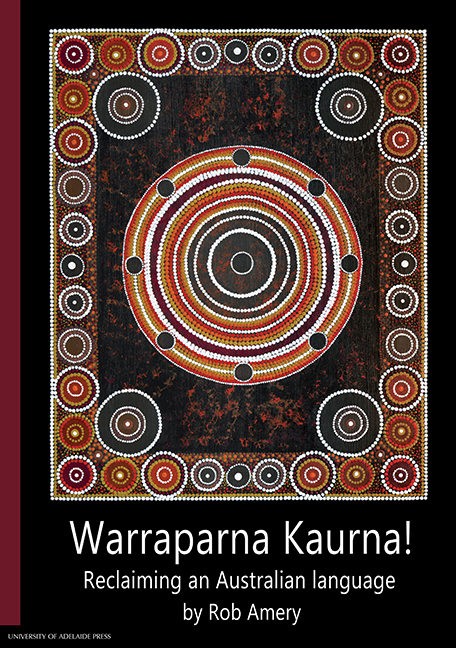Book contents
- Frontmatter
- Contents
- Maps, Plates, Graphs and Tables
- Preface to this Edition (2016)
- Foreword to the 2000 Edition
- Preface to the 2000 Edition
- Acknowledgements
- Abbreviations
- Conventions and Terminology
- Chapter 1 Locating the Study
- Chapter 2 Language Reclamation
- Chapter 3 An Ecological Approach to Language Revival
- Chapter 4 A Sociolinguistic History of Kaurna
- Chapter 5 Kaurna Sources
- Chapter 6 Restoring and Transforming the Kaurna Language
- Chapter 7 Kaurna Language Programs
- Chapter 8 Kaurna in Society
- Chapter 9 Kaurna Language Revival: The Formulaic Method
- Chapter 10 Sociopolitical Dimensions of Kaurna Language Revival
- Chapter 11 Into the Twenty-first Century: Developments since 2000
- Chapter 12 Summary and Conclusions
- Bibliography
- Index
Chapter 8 - Kaurna in Society
Published online by Cambridge University Press: 28 July 2017
- Frontmatter
- Contents
- Maps, Plates, Graphs and Tables
- Preface to this Edition (2016)
- Foreword to the 2000 Edition
- Preface to the 2000 Edition
- Acknowledgements
- Abbreviations
- Conventions and Terminology
- Chapter 1 Locating the Study
- Chapter 2 Language Reclamation
- Chapter 3 An Ecological Approach to Language Revival
- Chapter 4 A Sociolinguistic History of Kaurna
- Chapter 5 Kaurna Sources
- Chapter 6 Restoring and Transforming the Kaurna Language
- Chapter 7 Kaurna Language Programs
- Chapter 8 Kaurna in Society
- Chapter 9 Kaurna Language Revival: The Formulaic Method
- Chapter 10 Sociopolitical Dimensions of Kaurna Language Revival
- Chapter 11 Into the Twenty-first Century: Developments since 2000
- Chapter 12 Summary and Conclusions
- Bibliography
- Index
Summary
As long as you see steps all the time, you see time doesn't matter … if we'restarting to greet each other, then we start running meetings with it, then we'veopenings at your conferences, that's starting. All those things are fitting in.Every year you find extensions, and they're starting to multiply.
(Lewis O'Brien, interview transcript, 28 October 1997)This chapter focuses on the social aspects of Kaurna language reclamation, specifically the situations in which Kaurna is being used and the underlying purposes for its use. All aspects of Kaurna society and language revival are embedded within a dominant English-speaking culture. Kaurna people are currently establishing niches within this monolithic society. There has been a growing recognition of the value of multiculturalism in Australia, though multicultural Australia has been dominated by migrant groups; on this level, too, it has been necessary to seek out niches and fight for recognition. When people think about using Aboriginal languages, there is still strong pressure to turn to Pitjantjatjara, which is comparatively well known. The Kaurna are heavily outnumbered by the Ngarrindjeri and other groups in their own country, so the Kaurna have to fight for recognition on many fronts and many levels.
Within this context, the Kaurna people and Kaurna language enthusiasts have made significant gains. In Chapter 7 we saw that the Kaurna language is now taught in accredited programs at all levels of the education system, from early childhood to university studies. In this chapter, we shall see that it is gaining a higher profile in public domains, though it still plays only a small role. Most Adelaideans would probably confess to never having heard of the Kaurna people or language, let alone having heard the Kaurna language spoken.
Names and naming
Although names may seem an insignificant aspect of language use, Kaurna names remain one of the few areas of continuity. Many of the names on a map of the Adelaide plains are Kaurna; others that appeared on early maps of the area, even before colonisation, have been lost, though there are now proposals to reinstate them.
There has been a long-standing practice within the non-Aboriginal community of adopting ‘Aboriginal words’ to name suburbs, streets, railway sidings, properties, houses, boats, businesses, clubs and occasionally even persons.
- Type
- Chapter
- Information
- Warraparna Kaurna!Reclaiming an Australian language, pp. 203 - 233Publisher: The University of Adelaide PressPrint publication year: 2016

